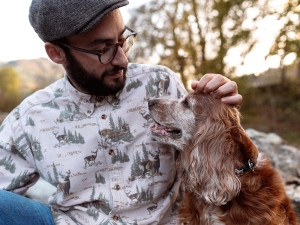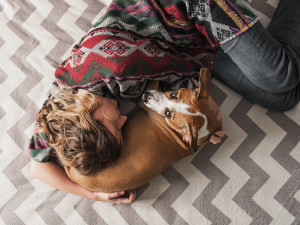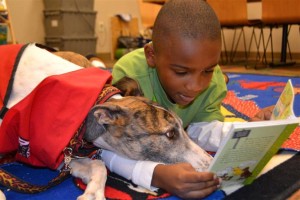Loneliness Is a Public Health Crisis. Pets Can Help
Per the US Surgeon General, loneliness is as dangerous for your health as smoking 15 cigarettes a day. Here are ways pets can solve that.

Share Article
Americans are lonelier than ever, and according to the United States Surgeon General, it’s not just a personal problem, it’s a public health crisis. On May 2, Dr. Vivek Murthy released an advisory titled: “ Our Epidemic of Loneliness and Isolation.” In it, Dr. Murthy argues that loneliness — defined in the report as “the subjective distressing experience that results from perceived isolation or inadequate meaningful connections,” — is as dangerous for one’s health as smoking 15 cigarettes a day.
“In recent years, about one-in-two adults in America reported experiencing loneliness,” Dr. Murthy writes. “And that was before the COVID-19 pandemic cut off so many of us from friends, loved ones, and support systems, exacerbating loneliness and isolation.”

Save on the litter with color-changing tech that helps you better care for your cat.
If you want to feel less isolated, Dr. Murthy suggests picking up a phone call from a friend or making time to share a meal. We would like to suggest a cuter, cuddlier solution: Hang out with animals.
According to a 2019 paperopens in a new tab from the Human Animal Bond Research Institute (opens in a new tabHABRI), spending time with the four-legged set is very good for you. “Science tells us that when people have a pet, they tend to get more exercise, report less loneliness and stress, and have stronger social ties,” the report reads. HABRI also found that 80 percent of pet parents they surveyed said their pets made them feel less lonely, and 54 percent said their pets helped them connect with other people.
Whether you are a pet parent or not, interacting with animals can help one feel less isolated and more connected, both with pets and with other humans. Below, some ways to get in some valuable pet time and help strengthen your mental, physical, and emotional health.
Adopt a Pet
The most obvious, perhaps. But if you’ve been on the fence about adopting an animal, and you feel confident you’d be able to care for them responsibly, consider this: According to HABRI, studies have found that pet parents are “more likely to meet physical activity guidelines, have a reduced risk of heart disease, and are more likely to be socially connected than non-pet owners.” Plus, you can feel good about helping out an animal in need, be it a tiny, orphaned spring kittenopens in a new tab, a foster animalopens in a new tab, or a dog rescued from the meat tradeopens in a new tab.
Volunteer at an Animal Shelter
If you don’t feel ready to bring an animal into your home full-time, you can still enjoy good animal vibes by helping out at local animal sheltersopens in a new tab. Many shelters need volunteersopens in a new tab to help with everything from walking dogs, animal socializing, cleaning, or basic admin. Besides getting quality time with cute animals, it can also be a great way to meet people who are also passionate about animals. You can sign up for a regular time slot, or just go whenever you can. Just remember to wear comfortable clothes and closed-toe shoes.
Foster a dog or cat
One of the best ways to help overburdened animal shelters is to sign up to be a foster parentopens in a new tab to animals. (And the need for foster volunteersopens in a new tab is incredibly high right now.) Letting a rescue animal live with you until they find their forever home helps lower the animal’s stress and can help you get a sense of whether you are ready to bring an animal into your home. And if you’re not, you can enjoy the emotional and physical benefits for however long your foster animal stays with you, and you can probably make some great human connections by getting to know others who are fostering.
Visit a Cat Café
One way to micro-dose cuteness and get an energy boost at the same time is by taking a trip to a cat cafeopens in a new tab. While the concept of the cat café has been most enthusiastically embraced in Japan, where there are more cat cafes than anywhere else in the world, there are over 125 cat cafés in the U.S. now, per CNNopens in a new tab. So, hopefully you can find one near you and spend a blissful hour sipping on coffee and petting the cats who will allow you to pet them.
Go to a Dog Park
Maybe you have a pet already but are looking to get out more and connect with other humans. Visiting a dog parkopens in a new tab is a great way for both you and your pup to do some valuable socializing. Your dog can run around and sniff butts, and you can meet new people with easy conversation starters like, “What’s your dog’s name?” and “Is that your dog trying to hump the other one?” Just make sure to keep a close eye on your dog, keep them hydrated, and don’t go if it’s too hot or too cold, and look for safe dog parksopens in a new tab that require vaccines, like DOG PPLopens in a new tab.
Puppy Classes
Maybe you’re way ahead of us and have already adopted a puppy to help with loneliness. But then, you get hit with the puppy bluesopens in a new tab: anxiety, sadness, and regret that your life has suddenly been consumed by this tiny, impossibly cute creature. Firstly, know you’re not alone. Secondly, a great way to connect with people who might also be experiencing the puppy blues is to attend a puppy class. Puppy classes are effectively puppy social hours, facilitated by an expert, where puppies around 12-weeks-old learn how to play nice together. In addition to being great places to meet other people who are dealing with the complications of a new puppy, as well as potential contacts for future playdates, these classes are almost criminally adorable to watch.
Training Classes
Whether you want to train your dog to be a Psychiatric Service Dogopens in a new tab (PSD), teach them agilityopens in a new tab, or take them to a basic obedience class opens in a new tabto strengthen their manners, taking your dog to a training class can be a great way to not only strengthen your connection with them, but also to meet other people who share similar interests.
So, basically, whatever you choose from the above list comes down to this: Spend time with animals. Even better if you’re helping out the overflowing shelters that are desperate for your help — and would love for you to cure your loneliness by stopping by.

Madeleine Aggeler
Madeleine Aggeler is a freelance journalist and copywriter in Washington, D.C. Previously, she was a writer at New York magazine’s The Cut. She lives with her dog, Cleo, who works primarily as a foot warmer.
Related articles
![girl with blue hair starting puppy training with white dog]() opens in a new tab
opens in a new tabPuppy Training 101: How to Train a Puppy
You gotta start somewhere.
![dogs at dog park drinking water and playing in pool]() opens in a new tab
opens in a new tabDog Park Etiquette: Dog Park Dos and Don’ts
New kid on the block? Follow this trainer’s tips before letting your pet run wild.
![Two Golden Retriever puppies playing with a large blue tennis ball outside in the grass]() opens in a new tab
opens in a new tabWhat to Expect at Puppy Socialization Classes
A dog behaviorist schools us on why puppy classes are more about socializing than getting straight As.
![A woman laying on a zig zag patterned blanket while curling around her brown and white dog]() opens in a new tab
opens in a new tabHow Do I Register an Emotional Support Animal?
Confused about ESA rules? Here’s a comprehensive guide that explains everything.
![Woman petting her small service dog.]() opens in a new tab
opens in a new tabWhat People Can and Can’t Ask You About Your Service Dog
The questions will come, so you should be prepared with answers.
![]() opens in a new tab
opens in a new tab5 Places Where Therapy Dogs Do Their Best Work
At airports, hospitals, schools, and more, therapy dogs make things better.









